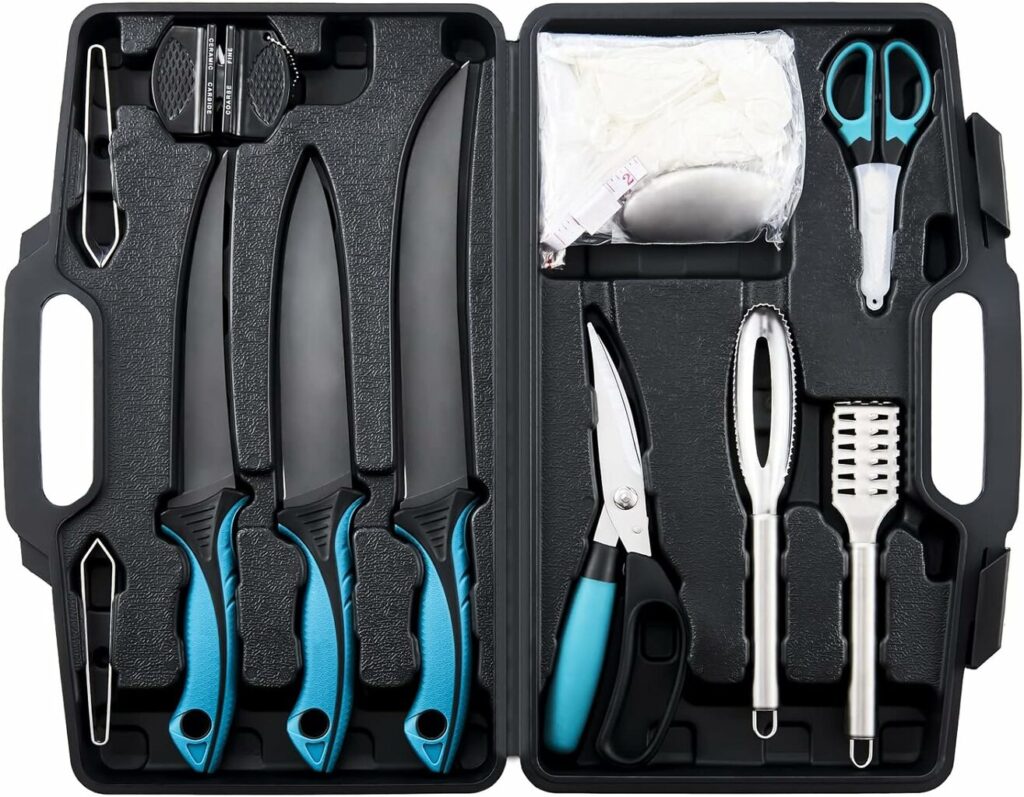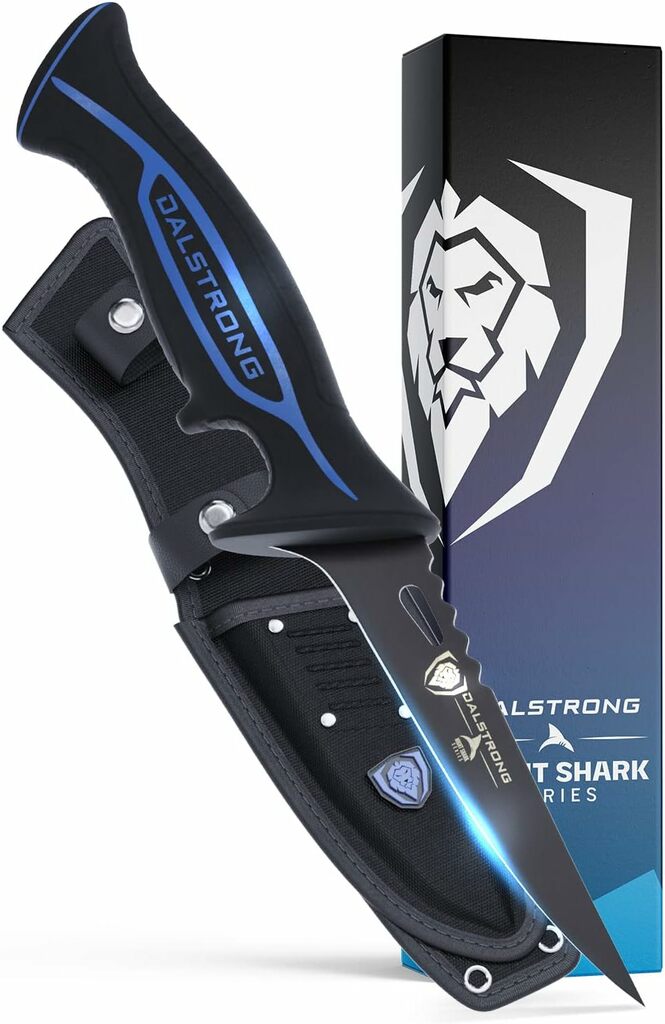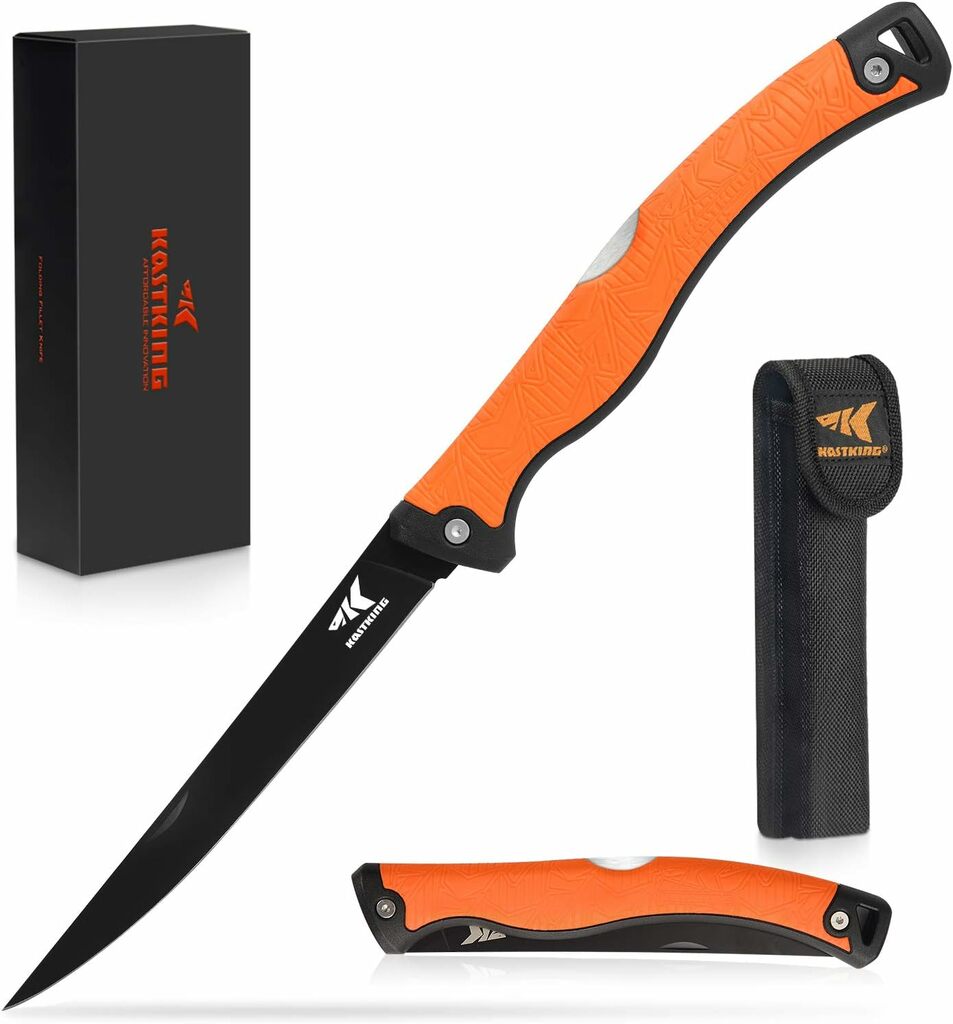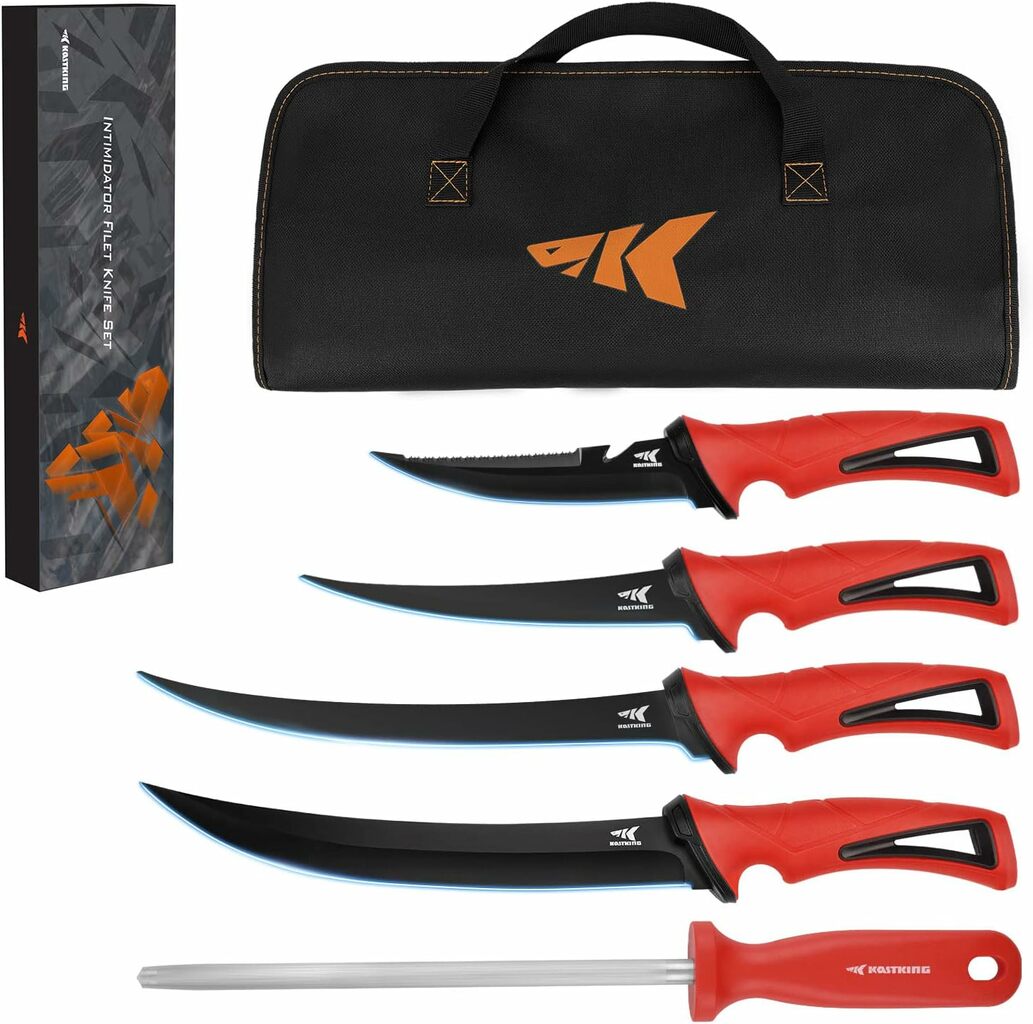“As an Amazon Associate I earn from qualifying purchases.”
Are you tired of struggling with dull and inefficient knives while preparing your catch of the day? Look no further! In this article, we will provide you with a comprehensive guide of the best fish fillet knives for 2024. We understand the importance of having a sharp and reliable fishing knife that can make your filleting tasks much easier and more enjoyable. Whether you’re a professional angler or a passionate fisherman, having the right tool can make a world of difference. So, let’s dive into the world of fish fillet knives and explore the top options available on the market, along with a buying guide to assist you in making the best choice for your needs. Say goodbye to struggling with dull blades and say hello to effortless and precise filleting!
Best cheap fillet knife
The KastKing Intimidator Bait Knife and Filet Knives are a must-have for any fishing enthusiast. The ultra-sharp G4116 German stainless-steel blades ensure clean and precise cuts, whether you’re filleting fish or preparing bait. The knives are designed for use in both fresh and saltwater, making them versatile and suitable for any fishing adventure.
One standout feature of these knives is the non-slip handle, which provides a firm grip, even when your hands are wet. This not only ensures your safety but also enhances your control over the knife. The durable storage bag is a great addition, as it allows for easy and safe transportation of the knives. Furthermore, the included honing rod enables you to keep the blades sharp at all times.
Overall, the KastKing Intimidator Bait Knife and Filet Knives are a top choice for fishermen and women looking for high-quality and reliable tools. The German stainless-steel blades, non-slip handle, durable storage bag, and honing rod make this set a great investment for any fishing trip.
Comes in flexible or stiff blade options
Good storage bag and honing rod included
Handle options available
Flexible 5-, 7-, and 9-inch blades
Sturdy and well-made knives
Not as maneuverable as shorter knives
Handles on longer blades are too short
Weight: 2.23 pounds Material: German Stainless-Steel Blades Brand: KastKing Color: E: Combo Kit Size: 16.61 Inches Washing: Hand Only

Best Fishing Knife Set overall
KNINE OUTDOORS Fish Fillet Knife Set
The KNINE OUTDOORS Fish Fillet Knife Set is a must-have for any angler. With its curved flex 7 inch and 9 inch fillet knives, this set is perfect for filleting and boning fish of all sizes. The non-slip handles provide a secure grip, ensuring precise cuts every time.
What sets this knife set apart is the inclusion of fishing braid line scissors, fish dressing scissors, and a filleting pad. These additional tools are a game-changer, making it easier to handle various aspects of the fish preparation process. The quality of the knives and accessories is outstanding, as expected from KNINE OUTDOORS. If you’re a fishing enthusiast looking for a durable, versatile, and reliable fillet knife set, look no further than this one.
Comes with additional tools
Comes with braid scissors, fish dressing scissors, and knife sharpener
Additional tools included
Includes carrying case
Includes 2 types of tweezers and 2 fish scalers
Knife sharpener is small
Handles could be more comfortable
Blade features: Flat, Curved flex Weight: 5.2 pounds Construction Type: Forged Dishwasher Safe: No Includes: fillet knife, fish bone tweezer, odor remover, gloves

Best fishing fillet knife
Dalstrong Night Shark Fillet Knife
The Dalstrong Fillet Knife from the Night Shark Series is a reliable and versatile tool for those who love outdoor activities like fishing. With a 4.7 inch titanium coated blade made from 7CR17MOV high carbon steel, this knife offers exceptional sharpness and durability. The polypropylene handle provides a comfortable grip, ensuring precise control even in wet conditions. Additionally, the included ballistic nylon sheath makes it easy to carry and protect the knife when not in use. NSF certified, this Dalstrong Fillet Knife is a great choice for any fishing enthusiast seeking a high-quality and reliable tool.
Very maneuverable
Reasonably priced
Limited Lifetime Warranty
Agile design
Attractive, sleek design
Handle shape may not be for everyone
Tang isn’t full length of handle, so balance could be better
Product Care: Hand Wash Only Weight: 1 pound Blade Edge: Plain Blade Length: 4.7 inch Use: Boning, Filleting, Deboning, Skinning Age: Adult Material: Stainless Steel+Polypropylene Handle

Best folding fillet knife
KastKing Camping Knife
The KastKing Folding Fillet/Fishing/Camping/Hunting Knife is a versatile tool that impresses with its quality and functionality. The G4116 German Stainless-Steel Blade is razor sharp, making it easy to slice through fish, bait, or any other material with precision. The non-slip handles provide a comfortable grip and ensure optimal control during use.
One of the standout features of this knife is its foldable design, allowing it to be conveniently stored and transported. With an overall length of 13 ½ inches, it provides plenty of reach and flexibility, while folding down to a compact 7 ½ inches. The included sheath is a nice touch, providing protection and easy access to the knife when needed.
Overall, the KastKing Folding Fillet/Fishing/Camping/Hunting Knife is a reliable and well-designed tool that is perfect for outdoor enthusiasts. Its versatility and durability make it a great addition to any angler’s or camper’s arsenal.
Handle design that works well for hunting or camping, too
Blade crafted from high-quality German steel
Razor-sharp blade
Includes sheath
Flexible blade for filleting
Blade is difficult to clean
Little flex in the blade
Handle: Rubber Blade: Stainless Steel Age: Adult Weight: 8.1 ounces Usage: For Camping Length: 6.5 Inches
Best Fish Fillet Knives: Reviewed
If you’re an avid angler or enjoy cooking up fresh catches from your fishing trips, a high-quality fish fillet knife is a must-have in your kitchen arsenal. Whether you’re filleting a delicate trout or a hefty salmon, having the right tool makes all the difference in achieving perfect fillets. In this article, we will review some of the best fish fillet knives available in the market.
First on our list is the renowned Shun Classic Flexible Fillet Knife. Known for its exceptional sharpness and precision, this knife is handcrafted in Japan using traditional techniques. The blade is incredibly flexible, allowing you to glide effortlessly along the contours of the fish to yield clean, boneless fillets. The ergonomic handle provides a comfortable grip, which is crucial for maintaining control during intricate filleting tasks.
Another standout is the Wusthof Classic 7-Inch Fillet Knife. Made from high-carbon stainless steel, this knife offers excellent edge retention and durability. The slender, flexible blade effortlessly separates the flesh from the skin, leaving you with clean fillets every time. The triple-riveted handle ensures a secure grip, enhancing safety during filleting. Its sharpness and versatility make it a popular choice among professional chefs and anglers alike.
Next up, we have the Rapala Fish n Fillet Superflex Knife, a true favorite among fishing enthusiasts. This knife boasts a stainless steel blade with a birch handle, designed to withstand harsh conditions and frequent use. The thin, tapered blade allows for precise cuts, making it ideal for intricate filleting work. Additionally, it comes with a convenient sheath that provides protection and easy portability, making it a reliable companion on your fishing trips.
When it comes to finding the best fish fillet knife, it’s essential to consider the knife’s sharpness, flexibility, and durability. Look for a knife that feels comfortable in your hand and offers excellent control. By investing in a high-quality fishing knife, you’ll be able to enjoy the art of filleting with ease and precision, ensuring the best possible fillets every time you cook up your catch.
Do You Need A Fishing License To Fillet Fish?
When it comes to fishing, there are certain rules and regulations that must be followed to ensure the conservation of fish populations and maintain the integrity of ecosystems. One common question that arises among anglers is whether or not it is necessary to have a fishing license in order to fillet fish. The answer to this question depends on your location and the specific laws of the area in which you are fishing.
In many places, a fishing license is required not only to catch fish, but also to possess or handle them. This means that even if you are simply filleting a fish that you have caught yourself, you may still need a license. This is because the act of filleting is considered part of the fishing process and therefore falls under the jurisdiction of fishing regulations. It is important to familiarize yourself with the laws of your specific area to determine whether or not a fishing license is required for filleting.
Using a fishing knife is a common tool for anglers when it comes to cleaning and filleting fish. However, it is important to note that possessing a fishing knife does not exempt you from needing a fishing license. The knife itself is merely a tool used in the process of cleaning fish, but it does not grant any special permissions or exemptions from fishing regulations. Therefore, even if you have a fishing knife, it is still essential to obtain the necessary fishing license if required in your area.
While the regulations regarding fishing licenses and filleting fish may vary from place to place, it is always prudent to err on the side of caution and ensure compliance with the law. Fishing licenses not only support the conservation and management of fish populations, but they also help to maintain sustainable fishing practices. By obtaining a fishing license, you can enjoy the experience of filleting fish while also contributing to the preservation of our natural resources and ensuring the future enjoyment of fishing for generations to come.
How Long Should A Fish Fillet Knife Be?
When it comes to preparing fish, having the right tools is essential. One of the most important tools for any angler or home cook is a fish fillet knife. But how long should a fish fillet knife be? The answer depends on several factors and personal preferences.
The length of a fish fillet knife is typically measured from the tip to the end of the handle. The most common sizes range from 6 to 9 inches, but there are even longer options available. The length you choose depends on the size of the fish you typically catch or work with. For smaller fish, a shorter knife may be sufficient, while larger fish may require a longer blade.
Another factor to consider is your level of experience. A longer knife may provide better control when filleting larger fish, but it also requires more skill and precision to maneuver. If you’re a beginner, a shorter knife may be easier to handle and control until you become more proficient in filleting techniques.
Ultimately, the choice of fish fillet knife length boils down to personal preference and the type of fishing you do. If you primarily fish for smaller species, a 6 to 7-inch knife may be suitable. However, if you target larger game fish, a longer blade, such as 8 to 9 inches, may be necessary.
In conclusion, selecting the right fish fillet knife length is a matter of personal preference and the size of the fish you frequently work with. Consider the size of the fish, your level of experience, and the type of fishing you do before making your decision. Investing in a quality fishing knife of an appropriate length will greatly enhance your ability to prepare fresh, delicious fish fillets with ease.
Why Is The Blade Thin And Flexible?
When it comes to choosing a fishing knife, one of the most important factors to consider is the blade’s thinness and flexibility. But why is it so crucial for a fishing knife blade to be thin and flexible? The answer lies in its functionality and performance while out on the water.
Firstly, a thin blade allows for precise and accurate cuts. Whether you’re filleting a fish or slicing through a tough bait, a thin blade provides the control needed to achieve clean and even cuts. It minimizes the chance of tearing or damaging the flesh, ensuring that your catch remains intact and the fillets come out perfectly.
Additionally, flexibility is vital because it allows the blade to bend and contour to the shape of the fish while filleting. This feature ensures that the blade can smoothly glide along the curves and contours of the fish’s body, minimizing waste and maximizing the yield of your fillets. A flexible blade also prevents the knife from getting stuck or jammed in bones or joints, making the filleting process more efficient and enjoyable.
Moreover, a thin and flexible blade reduces the effort required when using the fishing knife. The blade’s reduced thickness means less resistance, allowing you to effortlessly slice through the fish or bait without straining your hand or wrist. This feature is especially beneficial during long fishing trips when multiple catches need to be processed.
In conclusion, the thinness and flexibility of a fishing knife blade play a crucial role in its effectiveness and efficiency. They enable precise cuts, contour to the fish’s shape during filleting, and reduce the effort required by the angler. So, next time you’re shopping for a fishing knife, remember to prioritize these qualities to enhance your fishing experience and improve your filleting skills.
How To Use A Fish Fillet Knife
When it comes to preparing fish for cooking, having the right tools is essential. And one of the most important tools any fisherman or cook should have in their arsenal is a fish fillet knife. Designed specifically for removing the bones and skin from fish, a fish fillet knife can make the task quick and easy. But how exactly should you use a fish fillet knife to get the best results?
First, it’s important to ensure that your fish fillet knife is sharp. Dull blades can make the filleting process more difficult and can even result in accidents. So, make sure to sharpen your knife before starting. Once your knife is sharp, hold the fish firmly and make a small incision just behind the gills. Then, gently slice along the backbone, using long, smooth strokes. If you encounter any resistance, use the knife’s flexibility to navigate around the bones and remove them with care.
Next, once the fillet is separated from the rest of the fish, flip it flesh-side down and use the knife to remove the skin. Start at one end of the fillet and use a gentle sawing motion to separate the flesh from the skin, moving the knife back and forth until the skin is completely removed. Finally, rinse the fillet under cold water to remove any lingering scales or bone fragments.
In conclusion, using a fish fillet knife properly can make the process of preparing fish for cooking much easier. Make sure your knife is sharp, and be patient and careful as you remove the bones and skin. With practice, using a fish fillet knife will become second nature, and you’ll be able to prepare delicious, boneless fillets in no time. So, next time you’re preparing fish for a meal, be sure to use a fish fillet knife to make the job a breeze.
How To Care For Your Fish Fillet Knife
Whether you’re an avid angler or just someone who enjoys cooking fish, a fish fillet knife is an essential tool to have in your kitchen. To ensure that your knife remains in top condition and lasts for a long time, proper care is crucial. Here are some tips on how to care for your fishing knife.
Firstly, always clean your knife after each use. Fish residue can quickly dull the blade and cause it to corrode. Rinse the knife under running water, making sure to remove any scales, bones, or blood. For a more thorough clean, use mild dish soap and a sponge to gently scrub the blade. Avoid using abrasive cleaners or scrub brushes as they can damage the knife’s surface.
Drying your knife thoroughly is equally important to prevent rusting. After cleaning, use a soft cloth or towel to carefully pat the blade and handle dry. Make sure to dry the knife completely, including the handle and any crevices, to avoid any moisture buildup.
Next, it’s essential to store your fishing knife properly. Ideally, you should keep it in a protective sheath or a knife block to prevent accidental cuts and to keep the blade shielded from moisture and direct sunlight. If you don’t have a sheath or knife block, wrap the blade in a clean, dry cloth or store it in a plastic blade cover to protect it from scratches and other damages.
Lastly, regular sharpening will help keep your fish fillet knife in optimal condition. A dull blade not only makes filleting a challenge but can also lead to accidents due to increased force requirements. Use a sharpening stone or a honing rod to maintain the sharpness of your knife. Remember to follow the manufacturer’s instructions when sharpening and honing your fishing knife.
By following these simple care tips, you can keep your fish fillet knife sharp, clean, and ready for your next fishing adventure or delicious seafood meal. With proper care, your knife will remain in excellent condition for years to come, ensuring precision filleting and years of enjoyable cooking experiences.
Other Alternatives to a Fish Fillet Knife
When it comes to cleaning and preparing fish, having a good fishing knife is essential. However, a fish fillet knife is not the only tool that can get the job done effectively. There are several other alternatives that can be used for fish filleting, depending on personal preference and availability.
One popular alternative to a traditional fish fillet knife is an electric carving knife. Often used in the kitchen for slicing meats and bread, an electric carving knife can also work wonders on fish. With its sharp and serrated blades, it effortlessly cuts through the flesh, making it an efficient option for filleting.
Another option is a santoku knife, which is a Japanese multipurpose knife. While it may not have the flexible blade of a specialized fish fillet knife, the santoku knife’s sharpness and versatility make it a good alternative. Its broad and sturdy blade makes it great for slicing through a variety of fish, ensuring clean and precise cuts.
If you find yourself without a fishing knife or any of the above alternatives, you can still fillet a fish using a standard chef’s knife. While it may require a bit more skill and technique, a chef’s knife can still do the job. Just make sure it is sharp and take extra care to make precise cuts to get the fillets that you desire.
In conclusion, while a fish fillet knife is the go-to tool for many anglers and fish enthusiasts, it is not the only option available. Whether it’s an electric carving knife, a santoku knife, or even a standard chef’s knife, there are several alternatives that can be used effectively for fish filleting. Ultimately, the choice comes down to personal preference, availability, and the level of skill and technique one possesses.
What’s The Difference Between Boning And Filleting?
When it comes to preparing fish, two common techniques are boning and filleting. These methods require precision and a good fishing knife, but each has its own purpose and result. Understanding the difference between boning and filleting can enhance your cooking skills and make your fish dishes even more delicious.
Boning refers to the process of removing the bones from a fish. This technique is often used when you want to cook the fish whole but eliminate any unpleasant surprises while eating. With a boning knife, you carefully slide the blade along the bone structure, separating the meat from the bones. Proper boning requires skill and practice, as you need to remove the bones while keeping the fish intact and preserving its shape. Boning is particularly useful for larger fish that are often served in their entirety.
On the other hand, filleting involves removing the meat from the fish, leaving the bones behind. This technique is commonly used when you want to serve fish in fillet form, making it easier to eat and allowing for various cooking methods. To fillet a fish, a filleting knife is essential. With a steady hand, you make a clean incision along the backbone of the fish, followed by careful, smooth cuts to separate the fillet from the rest of the fish. Filleting is suitable for both smaller and larger fish, and it enables you to present the fish in an elegant, boneless form.
While both boning and filleting require skill and precision, they serve different purposes in the kitchen. Boning allows you to cook a whole fish without the hassle of dealing with bones, while filleting provides boneless fillets for more versatile cooking options. Whichever technique you choose, having a sharp fishing knife and practicing the proper skills will ensure that you can prepare your fish with ease and enjoy a delicious meal.
Who Makes The Best Fish Fillet Knife?
When it comes to preparing fresh fish, having the right tool for the job is crucial. And that’s where a fish fillet knife comes in. But with so many options on the market, it can be overwhelming to determine which brand makes the best fish fillet knife. Fear not, as I’ve done the research for you! After comparing the top brands and considering customer reviews, two brands stood out as the frontrunners: Victorinox and Wusthof.
Victorinox is known for producing high-quality knives, and their fish fillet knives are no exception. Their blades are made from high-carbon stainless steel, ensuring sharpness and long-lasting durability. The handles are ergonomically designed for a comfortable grip, making the filleting process effortless. Victorinox offers a range of sizes to accommodate different types of fish, making it a versatile choice for any angler.
Wusthof, another esteemed brand in the cutlery world, also excels in producing top-notch fish fillet knives. Their blades are forged from high-carbon stainless steel, providing excellent sharpness and precision. Wusthof’s knives feature a full tang design, which means the blade extends through the handle for added strength and balance. Additionally, their handles are crafted from synthetic material, ensuring a secure grip even when wet.
Choosing the best fish fillet knife ultimately comes down to personal preference and budget. Both Victorinox and Wusthof offer exceptional quality and performance, making them reliable choices for anglers and fish enthusiasts alike. Whether you’re a professional fisherman or an occasional cook, investing in a high-quality fish fillet knife will elevate your culinary experience and make the process of filleting fish a breeze. So, get ready to channel your inner chef and enjoy perfectly filleted fish every time.
“As an Amazon Associate I earn from qualifying purchases.”

